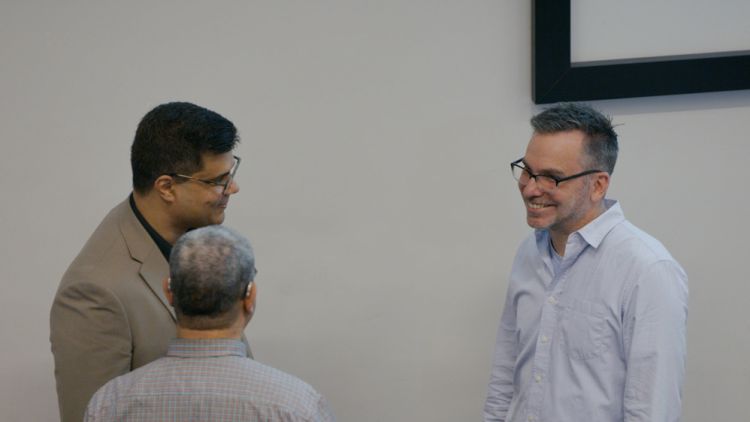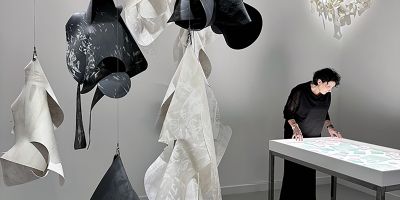The School of Design Leads the Visible Language Journal into a New Era

Visible Language, the longest running peer review design journal, has entered a dynamic new chapter with the launch of Issue 59.1, the first issue published under a new consortium model.
This collaborative approach unites three leading institutions: The School of Design at the University of Leeds, the University of Cincinnati, and North Carolina State University. Together, they form the journal’s new editorial board, shaping its direction and ensuring its continued relevance to the global design community.
University of Leeds Hosting
From 2025 to 2027, the University of Leeds will serve as the lead institution and host of Visible Language. Professor Maria Lonsdale Head of the School of Design, will take on the role of Editor-in-Chief, supported by Dr. Jeanne-Louise Moys (Associate Editor), Dr. Arjun Khara (Assistant Director), and Dr. Matthew Baxter (Editorial Manager). Reflecting the School’s interdisciplinary ethos, this team brings together diverse perspectives and expertise in design research and practice. The Visible Language Editorial Board will include the same roles from the University of Cincinnati – Professor Mike Zender (Editor), Muhammad Rahman (Associate Editor), D. J. Trischler (Assistant Editor); and from North Carolina State University – Dr Matthew Peterson (Editor), Dr Deborah Littlejohn (Associate Editor), Dr Helen Armstrong (Assistant Editor).
Open access for authors and readers
This transition marks a milestone in the journal’s almost 60-year history. Most importantly, the consortium ensures the journal’s financial and editorial independence while maintaining the high standards of peer-reviewed research. This financial independence also allows for the journal to adopt a “diamond open access” model, free for both authors and readers. Visible Language is now a truly open-access platform: readers worldwide can access every issue free of charge, and contributors can publish without fees. This inclusive vision supports the global exchange of ideas, research, and practice in design.
It is my true honour to represent the first of the three universities to host Visible Language for the next three years,” says Professor Maria Lonsdale. “Visible Language is now the design journal that everyone around the world, with no exception, can access and enjoy free of charge, publish their research and practice also free of charge, and learn from others in order to inform their research, practice, or studies.
World Leading Research
The University of Leeds’ appointment as lead institution for Visible Language from 2025 – 2027 reflects the School of Design’s global reputation and dedication to research excellence. In REF 2021, 81% of the School’s research was rated ‘’world-leading’’ or ‘’internationally excellent.’’
Notably, 100% of the School of Design’s research environment was classified as “world-leading,” and 90% of its impact case studies achieved the top two grades. Visible Language’s open access fits perfectly with the school’s ethos and longstanding approach to nurturing the best research environment and culture for its academics, researchers and students. Visible Language is also now indexed by Scopus, further elevating its academic standing, particularly valuable in countries like the UK, where research outputs are assessed through frameworks like the Research Excellence Framework (REF).
Collaboration and connectivity are at the core of the School of Design, forming and joining the Visible Language Consortium. Researchers at the School frequently engage with partners worldwide, and the outcomes of these partnerships are reflected in the school’s exceptional REF performance. Forming the Consortium and hosting Visible Language in the first three years is a natural extension of this work, a platform to amplify and connect outstanding global design research.
Volume 59 - Reflecting on Past, Present, and Future
To celebrate this new beginning, Volume 59 will focus on the journal’s three core audiences across three themed issues:
-
Issue 59.1 – Past: A tribute to long-standing contributors who have helped shape the field of communication design.
-
Issue 59.2—Present: This issue explores contemporary trends and practices, focusing on integrating AI into design workflows. It will showcase collaborations between academic researchers and industry practitioners.
-
Issue 59.3 – Future: A platform for emerging voices, highlighting collaborations between doctoral researchers and their supervisors and spotlighting research that will define the future of the field.
Through this renewed mission, led by the School of Design at the University of Leeds in the first three years (2025-27), Visible Language reaffirms its role as a vital and inclusive platform for bridging research and practice in the global design community.




